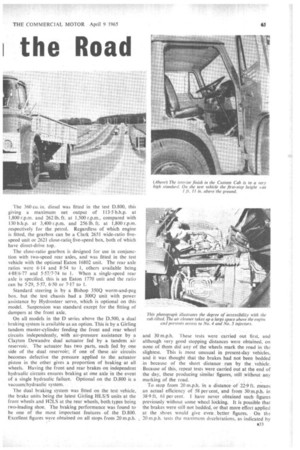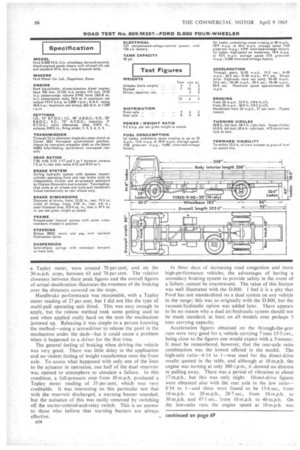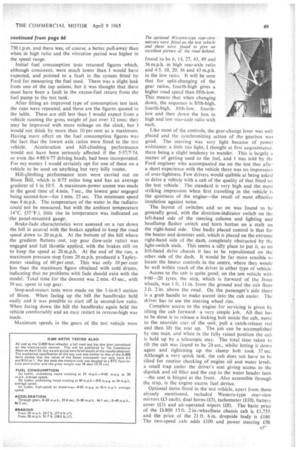Good on Paper Good the Road
Page 66

Page 67

Page 68

Page 71

If you've noticed an error in this article please click here to report it so we can fix it.
By A. J. P. Wilding
A M I Mech E MI RTE
ROAD TEST: Ford D.800 Four-wheeler THE Ford D series has been worth waiting for. The specifications of the new models, with their wide variety of optional items, look good on paper and after carrying out a full road test on the heaviest capacity _four-wheel rigid in the range—the D.800—I forecast considerable success for the design in actual service.
To some extent the test was marred by inadequate preparation of the vehicle supplied by Ford. It had only completed about 800 miles at the start of the test and thus was only just "run in ". This, however, was not such a bad thing, as the results obtained can be taken as being the worst obtainable with the vehicle. After about 2,000 or .so miles performance should improve,. and the brakes would be fully bedded in. But even so, the figures obtained were ,generally good for a vehicle of this class and the braking performance was excellent. Two series of fuel consumption tests had to be carried out because of a fault in the fuel-measuring system fitted by Ford—consumptions of around 9 m.p.g. obtained on the first day bbviously
were wrong—when retested, reasonable figures resulted.
From a driver's point of view, the D series cannot be faulted. On the test D.800, the Custom Cab was fitted— this is standard on the model—and gives an extremely high degree of comfort. All controls are well placed and easy to operate, the fittings are to a high standard and all-round visibility is very good.
Whilst the general pattern of the D series is variety of specification to meet all possible requirements, the D.800 models have a relatively rigid specification. In addition to the 15 ft. 2 in.-wheelbase version tested, there are four others offered. These are 10 ft., 11 ft. 2 in., 13 ft. and 17 ft. 2 in., each obtainable with a standard-length body-14 ft., 16 ft., 18 ft. 6 in. and 24 ft. 0 in., respectively—compared with the 24 ft.-long body on .the test vehicle. Only one gross weight rating for the D.800 used solo is quoted, this being 27,500 lb., or 108 lb. less than the 12 tons 6.5 cwt. of the test vehicle. But when used with a trailer, the g.c.w. can be up to 42,000 lb. (18.8 tons) when the 360 cu. in. diesel engine is fitted, or 39,000 lb. (17.4 tons) if the 300 Cu. in. petrol-engine option is specified. The 360 cu. in. diesel was fitted in the test D.800, this giving a maximum net output of 113-5 b.h.p. at 1,800 r.p.m. and 262 lb. ft. at 1,500 r.p.m., compared with 130 b.h.p. at 3,400 r.p.m. and 256 lb. ft. at 1,800 r.p.m. respectively for the petrol. Regardless of which engine is fitted, the gearbox can be a Clark 2651 wide-ratio fivespeed unit or 2621 close-ratio, five-speed box, both of which have direct-drive top.
The close-ratio gearbox is designed for use in conjunction with two-speed rear axles, and was fitted in the test vehicle with the optional Eaton 16802 unit. The rear axle ratios were 6-14 and 8-54 to 1, others available being 4.8816.77 and 5-57/7.74 to 1. When a single-speed rear axle is specified, this is an Eaton 1770 unit and the ratio can be 5.29, 5.57, 6.50 or 7.17 to 1.
Standard steering is by a Bishop 350Q worm-and-peg box, but the test chassis had a 300Q unit with power assistance by Hydrosteer servo, which is optional on this model Suspension was standard except for the fitting of dampers at the front axle.
On all models in the D series above the D.500, a dual braking system is available as an option. This is by a Girling tandem master-cylinder feeding the front and rear wheel circuits independently, with air-pressure assistance by a Clayton Dewandre dual actuator fed by a tandem air reservoir. The actuator has two parts, each fed by one side of the dual reservoir; if one of these air circuits becomes defective the pressure applied to the actuator piston in the other gives a proportion of braking at all wheels. Having the front and rear brakes on independent hydraulic circuits ensures braking at one axle in the event of a single hydraulic failure. • Optional on the D.800 is a vacuum/hydraulic system.
The dual braking system was fitted on the test vehicle, the brake units being the latest Girling HLS/S units at the front wheels and H2LS at the rear wheels, both:types being two-leading shoe. The braking performance was found to be one of the most important features of the D.800. Excellent figures were obtained on all stops from 20 m.p.h.
and 30 m.p.h. These -tests were carried out first, and although very good stopping distances were obtained, on none of them did any of the wheels mark the road in the slightest. This is most unusual in present-day vehicles. and it was thought that the brakes had not been bedded in because of the short distance run by the vehicle. Because of this, repeat tests were carded out at the end of the day,. these producing similar figures, still -without any
marking of the road. . _ To stop from 20 m.p.h. in a distance .of 22.9 ft. means an actual efficiency of 58 per cent, and from 30 m.p.h. in 38-9 ft, 61 per cent. I have never obtained such'-figures previously without some wheel loCking. It is possible that the brakes were still not bedded, or that more effort applied at the shoes would give even better figures. On the , 20 m.p.h. tests the maximum decelerations, as indicated by a33 a Tapley meter, were around 70 percent, and on the 30 m.p.h. stops, between 65 and 70 per cent. Therelative closeness between these peak figures and the overall figures of actual deceleration illustrates the evenness of the braking over the distances covered on the stops.
Handbrake performance was reasonable, with a Tapley meter reading of 27 per cent, but I did net like the type of multi-pull operating unit fitted. This was easy enough to apply, but the release method took some getting used to and when applied really hard on the tests the mechanism jammed up. Releasing it was simple to a person knowing the method—using a screwdriver to release the pawl in the mechanism under the dash—but it could cause a problem when it happened to a driver for the first time.
The general feeling of braking when driving the vehicle was very good. There was little delay in the application and no violent feeling of weight transference onto the front axle. To assess what happened with only one of the lines to the actuator in operation, one half of the dual reservoir was opened to atmosphere to simulate a failure. In this condition, a full-pressure stop from 30 m.p.h. produced a Tapley meter reading of 35 per cent, which was very creditable. It was interesting on this particular test that with the reservoir discharged, a warning buzzer sounded; but the nuisance of this was easily removed by switching off the starter-control-and-relay switch. This is an answer to those who believe that warning buzzers are always effective.
B34 In these days of increasing read congestion and more high-performance vehicles, the advantages of having a secondary braking system to provide safety in the event of a failure, cannot be overstressed. The value of this feature was well illustrated with the D.800. I feel it is a pity that Ford has not standardized on a dual system on any vehicle in the range; this was so originally with the D.800, but the vacuum/hydraulic option was added later. There appears to be no reason why a dual air/hydraulic system should not be made standard, at least on all models over perhaps 5 tons carrying capacity.
Acceleration • figures obtained on the through-the-gear runs were very good for a vehicle carrying 7 tons 15-5 cwt., being close to the figures one would expect with a 5-tonner. It must be remembered, however, that the rear-axle ratio combination was the lowest offered in the model. The high-axle ratio-614 to 1—was used for the direct-drive results quoted in the table, and although at 10 m.p.h. the engine was turning at only 500 rpm., it showed no distress in pulling away. There was a period of vibration at about 17 m.p.h., but this was only slight. Direct-drive figures were obtained also with the rear axle in the low ratio8.54 to I—and these were found to be 15-6 sec., from 10 m.p.h. to 20 m.p.h., 28-7 sec., from 10 m.p.h. to 30 m.p.h. and 47-1 sec., from 10 m.p.h. to 40 m.p.h. On the low-ratio runs the engine speed at 10 m.p.h. was
750 r.p.m. and there was, of course, a better pull-away than when in high ratio and the vibration period was higher in the speed range.
Initial fuel consumption tests returned figures Which, although consistent, were much lower than 1 would have expected, and pointed to a fault in the system fitted by Ford for measuring the fuel used. There was a slight leak from one of the tap unions, but it was thought that there must have been a fault in the excess-fuel return from the fuel pump to the test tank.
After fitting an improved type of consumption test tank the runs were repeated, and these are the figures quoted in the table. These are still less than I would expect from a vehicle running the gross weight of just over 12 tons; they may be improved with more mileage on the clock, but I would not think by more than 10 per cent as a maximum. Having more effect on the fuel consumption figures was the fact that the lowest axle ratios were fitted in the test vehicle. Acceleration and hill-climbing performance would not have been seriously affected if the 5.57/7.74, or even the 4.88/6-77 driving heads, had been incorporated. For my money I would certainly opt for one of these on a vehicle to be used on anything but very hilly routes.
Hill-climbing performance tests were carried out on Bison hill, which is 0.75 miles long and has an average gradient of I in 10.5. A maximum-power ascent was made in the good time of 4 mm. 7 sec., the lowest gear engaged being second-low—for 1 mm. 25 sec. The minimum speed was 8 m.p.h. The temperature of the water in the radiator could not be measured, but with the ambient temperature 14°C. (57°F.), little rise in temperature was indicated on \the panel-mounted gauge.
• Brake-fade characteristics were assessed on a run down the hill in neutral with the brakes applied to keep the road speed down to 20 m.p.h. At the bottom of the hill where the gradient flattens out, top gear (low-axle ratio) was engaged and full throttle applied, with the brakes still on to keep the speed at 20 m.p.h. At the end of the run, a maximum pressure stop from 20 m.p.h. produced a Tapleymeter reading of 60 per cent. This was only 10 per cent less than the maximum figure obtained with cold drums, indicating that no problems with fade should exist with the model. Total time for the descent was 2 min. 43 sec., with 39 sec. spent in top gear.
Stop-and-restart tests were made on the 1-in-6-5 section of Bison. When facing up the hill the handbrake held easily and it was possible to start off in second-low ratio. When facing down the hill the handbrake again held the vehicle comfortably and an easy restart in reverse-high was made.
Maximum speeds in the gears of the test vehicle were found to be 6, 14, 27, 43, 49 and 56 m.p.h. in high rear-axle ratio and 4.5, 10, 20, 36 and 43 m.p.h. in the low ratio. It will be seen that for split-changing of the gear ratios, fourth-high gives a higher road speed than fifth-low. This means that when changing down, the sequence is fifth-high, fourth-high, fifth-low, fourthlow and then down the box in high and low rear-axle ratio with each.
Like most of the controls, the gear-change lever was well placed and the synchronizing action of the gearbox was good. The steering was very light because of power assistance: a little too light, I thought at first acquaintance, there being a slight tendency to wander. This is largely a matter of getting used to the feel, and I was told by the Ford engineer who accompanied me on the test that after a short experience with the vehicle there was no impression of over-lightness. Few drivers would quibble at being asked to drive a vehicle with a cab of the quality of that fitted on the test vehicle. The standard is very high and the most striking impression when first travelling in the vehicle the quietness of the engine—the result of most effective insulation against noise.
The layout of switches and so on was found to be generally good, with the direction-indicator switch on the left-hand side of the steering column and lighting and headlamp flasher switch and horn button on a stalk on the right-hand side. One badly placed control is that for the heater and demister unit, which is placed on the extreme right-hand side of the dash, completely obstructed hy the light-switch stalk. This seems a silly place to put it, as on left-hand drive chassis it has to be repositioned on the other side of the dash. It would be far more sensible to locate the heater controls in the centre, where they would be well within reach of the driver in either type of vehicle.
Access to the cab is quite good; on the test vehicle with 9.00-20 tyres, the step, which is forward of the front wheels, was 1 ft. 11 in. from the ground and the cab floor 3 ft. 2 in. above the road. On the passenger's side there is a grab handle to make ascent into the cab easier. The driver has to use the steering wheel rim.
Complete access to the engine for servicing is given by tilting the cab forward—a very simple job. All that has to be done is to release a locking bolt inside the cab, move to the nearside rear of the unit, pull a catch-release rod and then lift the rear up. The job can be accomplished by one man, and when in. the fully raised position the cab is held up by a telescopic stay. The total time taken to tilt the cab was found to be 24 sec., whilst letting it down again and tightening up the clamp bolt took 37 sec. Although a very quick task, the cab does not have to be tilted for routine checking of engine oil and water levels, a small trap under the driver's seat giving access to the dipstick and oil filler and the cap to the water header tank —the seat is hinged at the front. Also accessible through the trap, is the engine excess fuel device.
Optional items fitted in the test vehicle, apart from those already mentioned, included Western-type rear-view mirrors (£5 each), dual horns .1£3), tachometer (10), battery cover (£1) and air-operated wipers (8). The basic price of the D.800 15 ft. 2 in.-wheelbase chassis cab is £1,755. and the price of the 21 ft. 6 in. dropside body is £180 The two-speed axle adds £100 and power steering £50




































































































































